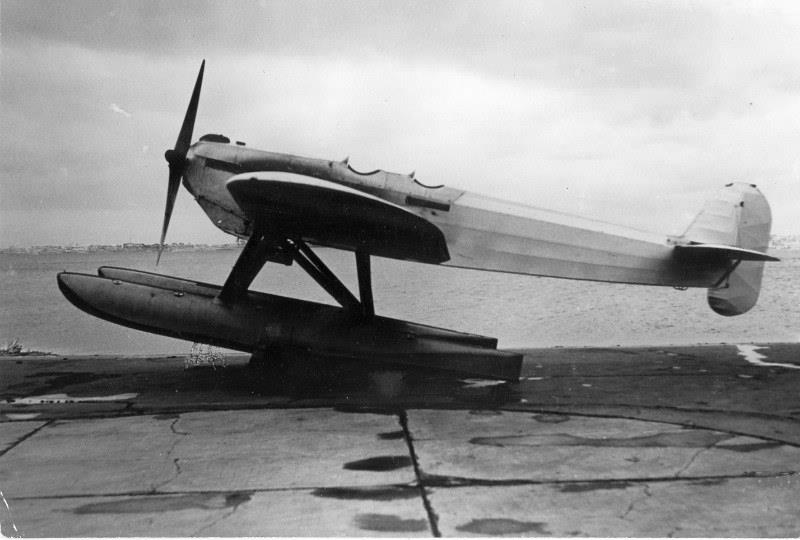| Type |
2-seat fighter seaplane |
| Engine |
Packard 3A 2500 5,1 with fixed 4-bladed wooden propeller |
1 Napier "Lion" XI with fixed 4-bladed wooden propeller
|
| Dimensions |
Length 12,2 m , height 4,50 m, span 16,8 m , wing area 47,9 m2 , |
| Weights |
Empty 2255 kg, loaded 2505 kg, normal startweight 3150 kg , max. take off weight |
| Performance |
Max.. speed 250 km/h , landing speed 95 km/h, cruising speed , range 926 km, endurance 3,5 h , service ceiling 5200 m , climb 6,7 m/sec., to 1000 m 2,30 min. |
| Armament |
|
| Type |
Werk.Nr |
Registration |
History |
|
310 |
D-1522 |
Built October 1928. To DVL, Erprobungsstelle Travemünde In October engine change to Napier "Lion" |

The aircraft was created in response to a request from the Reichsmarine for a two-seater sea fighter with sea capability up to sea states 2 to 3 and two fixed machine guns as offensive armament and a mobile machine gun for defense in the observer position, similar to the design of the successful Hansa-Brandenburg W.29, the Ernst Heinkel had already designed during the First World War. Use as a reconnaissance aircraft was also considered. Heinkel developed the HE 31 as an improved successor to the proven HE 5 from 1926 in a similar design as a two-seater low-wing aircraft, but with improved wings with decreasing profile thickness. An example was built that, for the first time in the company's history, had two floats rounded on the top because it was hoped that this would reduce air resistance and thus increase speed. It was powered by an American Packard engine with 840 hp. The only HE 31 with the serial number 310 was produced in 1928 and registered in October for Severa GmbH, a front company for the Reichsmarine, as D-1522. After testing by the Severa, Deutsche Luft Hansa (DLH) incorporated it into its coastal flight department in February 1929, but in June 1929 it became part of the German Aviation Research Institute (DVL) in Adlershof, with the testing center of the Reich Association of the German Aviation Industry (RDL) in Travemünde acted as holder. In October 1931 the aircraft received a British Lion XI-a engine with 576 hp and was finally taken over by the RDL, who subjected it to some tests in its See test center. Series production was not envisaged as the HE 31 was seen as merely an intermediate step from the HE 5 to the HE 9 as a successor and the Reichsmarine preferred the latter in its 1929 procurement planning due to its domestic BMW engine.
The HE 31 was designed as a semi-cantilever low-wing monoplane in mixed construction. The fuselage consisted of a welded, trussed tubular steel frame with a rectangular cross-section, a curved top and a tail ending in a vertical cutting edge. In the engine area up to the rear edge of the observer's cabin it was covered with duralumin sheets and covered with fabric behind it. There was a firewall made of sheet steel between the engine and the front cabin.
The HE 31 had two-spar, rectangular wings with elliptical edge arches and a V position of 2.5°. They were made in two parts, had inner struts made of tubular steel and belts made of spruce between the spars. In the area of the wing nose they were covered with plywood and otherwise covered with fabric. The connection to the fuselage was ensured by hook joints. On the underside, at half the span, there were N-braces that supported the wing towards the floats.
The components of the tail unit consisted of fabric-covered tubular steel frames, the vertical and horizontal tail fins were braced with wire. The rudder was aerodynamically balanced. The HE 31 was equipped with two semicircular wooden floats with stepped duralumin bases, each with a volume of 1,560 liters.
Reference
Volker Koos: Ernst Heinkel Flugzeugwerke 1922–1932.
Volker Koos: Luftfahrt zwischen Ostsee und Breitling. Der See- und Landflugplatz Warnemünde 1914–1945.
Helmut Stützer: Die deutschen Militärflugzeuge 1919–1934.
